Fireflies are common throughout the world. They are more common in tropical climates. There are more than two thousand firefly species described globally, one hundred and sixty can be found in the United States.
If you are wondering if you have seen a firefly or what firefly you saw, continue reading for the most common fireflies you can encounter in the United States.
Fireflies are enchanting as they light up backyards on a hot summer night. Most of us have encountered them at some point in our lives.
Table of Contents
Appearance
Something you may not have known is that a firefly is not a fly at all. It is a soft-bodied beetle that grows from 5mm to 25mm in body length. They are flat beetles, black or dark brown, with orange or yellow.
They vary considerably in terms of size, shape, color, and features. Adults will differ in size based on species with the largest firefly being 25mm.
Diet
Firefly larvae are carnivorous. They prefer snails, while the adults prefer pollen or nectar. Some adults do not feed at all. Some firefly species are carnivorous as adults, feeding on other genera.
Behavior
A firefly will come out mostly in the evening, around sunset. The males start to fly low to the ground, using their flashing signals to attract prey or a mate. The female remains on the ground and uses her flash to attract the male.
Females can lay up to five hundred eggs in damp soil. The electroluminescence of fireflies is nearly one hundred percent efficient, they use very little energy to produce light.
Habitat
In most cases, you will see fireflies around the water. They are common near streams, marshy areas, ponds, and rivers. You may encounter them in forests, meadows, and fields. Though their habitats are reducing due to development.
Types of Fireflies
With there being more than one hundred and sixty firefly species in the United States, we have listed the most common species. These are the fireflies you are likely to encounter in your backyard or when exploring nature.
1. Common Eastern Firefly
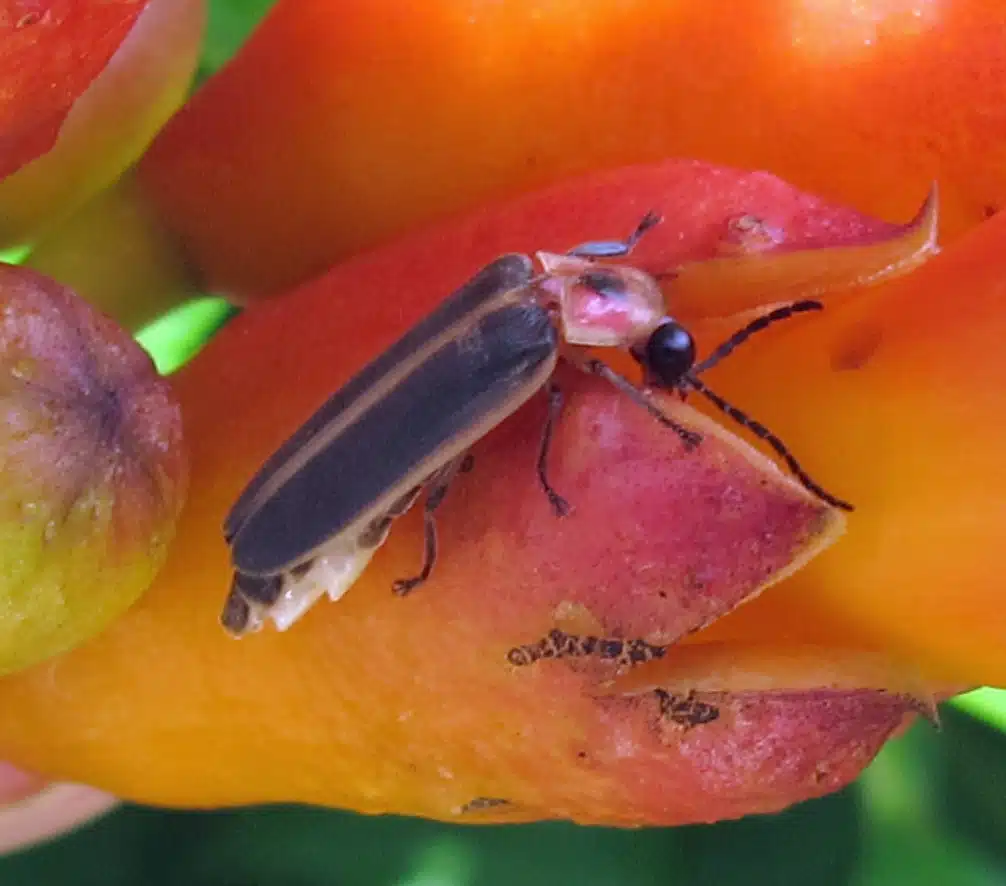
The Common Eastern Firefly (Photinus pyralis) is also known as the big dipper firefly and is common in North America. It is a flying beetle that can produce light. The light organ is located on the ventral side of the abdomen.
The females are known to lure Photinus pyralis, obtaining their spider-repellent steroids. Males’ light organs cover the entire ventral surface of the three posterior segments. In females, the light portion only covers the third posterior segment.
You are likely to see this firefly at twilight when they hover close to the ground. The male flies in a J-shaped trajectory and lights on the upswing. During the flight, they use the J-shaped pattern in combination with flash patterns to find a suitable female.
The male uses a series of light flashes to locate a female. The female responds with a coded delayed flash. The light organ comprises of two layers, a layer of retractile cells on the dorsal side and a photic layer on the ventral side.
Pupae have a different light organ than adults. The pupae emit a low-intensity glow rather than a flash of light.
They use unpleasant odors as a defense, along with a sticky excretion to avoid predators. Predators can get entangled in the sticky excretion, while others are repulsed by the unpleasant odor. Both of these have proven very effective at protecting the firefly.
The males are prey for the female of a different genus. Photuris females mimic the males’ light signaling patterns, luring the male. The males produce a steroid, lucibugagin, which is why the females prey on the males. Once the females gain the steroid, they use it to protect themselves against jumping spiders.
2. Winter Firefly
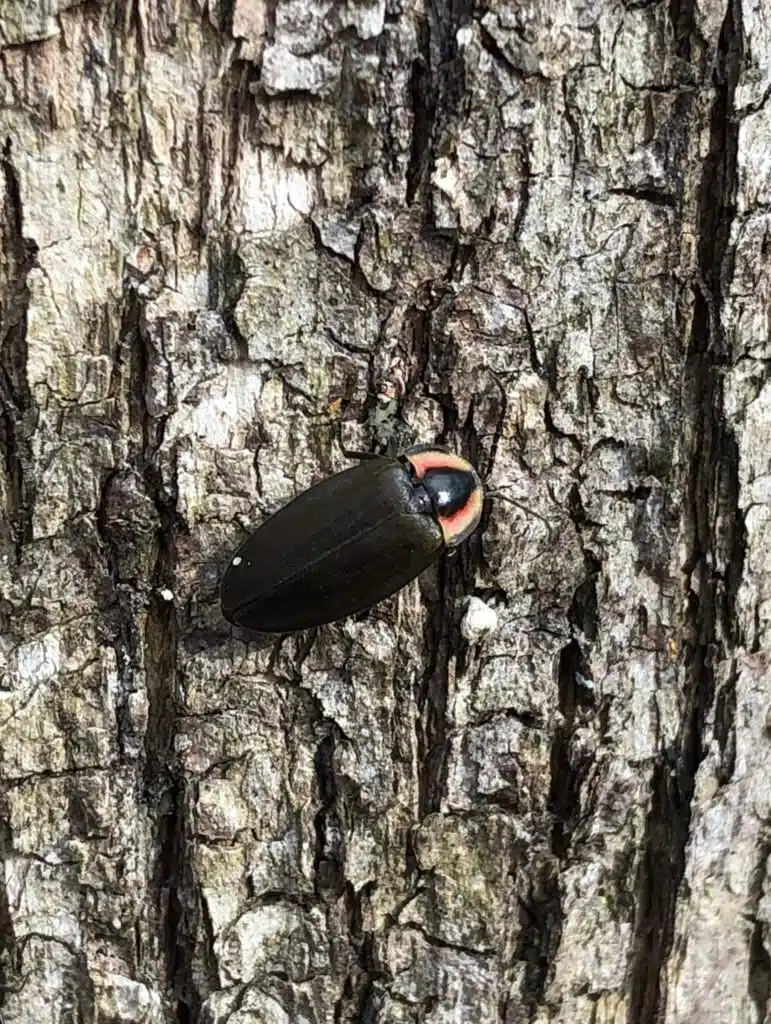
The Winter Firefly (Ellychnia corrusca) belongs to the Ellychnia genus. It is a lantern-less beetle that is common throughout the United States. They are a diurnal beetle with a six-week mating period, which takes place from April to mid-May.
The mating process involves the adults crawling around tree trunks in search of a mate. This takes place in early spring. The males contact females with their antennae.
This is a species in the firefly family. They are known to visit flowers in the prairie willow, rhododendron, and northern spicebush family. They can grow to 12mm in body length.
3. Black Firefly
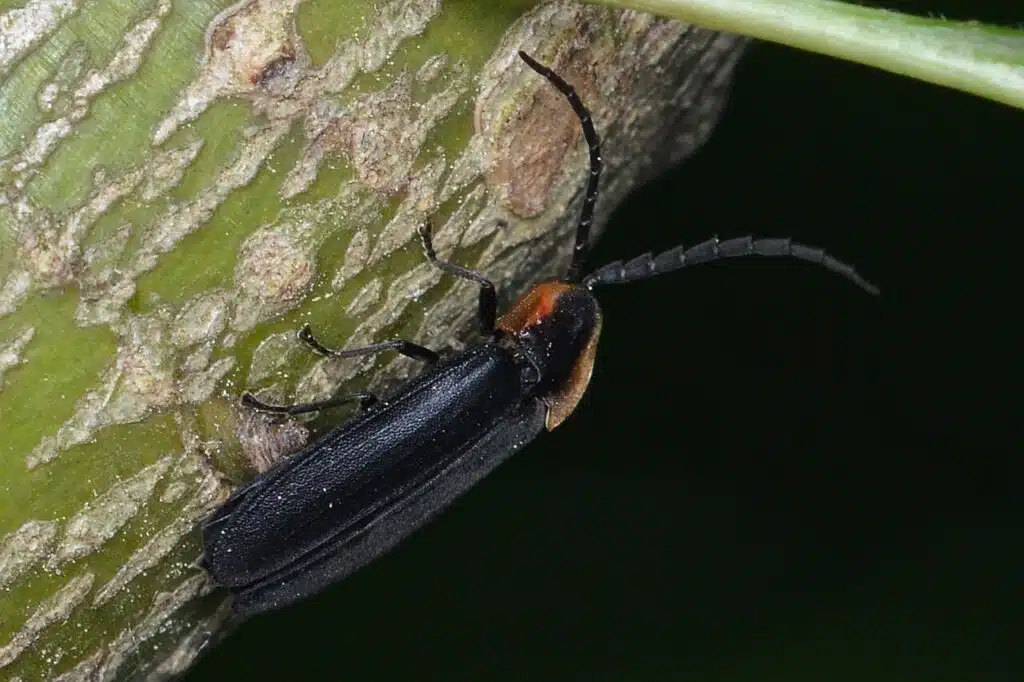
The Black Firefly (Lucidota atra) can grow to 12mm in body length. This beetle is segmented with black antennae that are serrated. The pronotum extends over the head and is red and yellow with a black stripe or patch.
It has small comp9ound eyes. The light organ is reduced and difficult to identify in the adult beetle. This firefly is active during the day. The larvae live in moist environments, which include decaying wood, where they prey on soft-bodied invertebrates.
4. California Glowworm
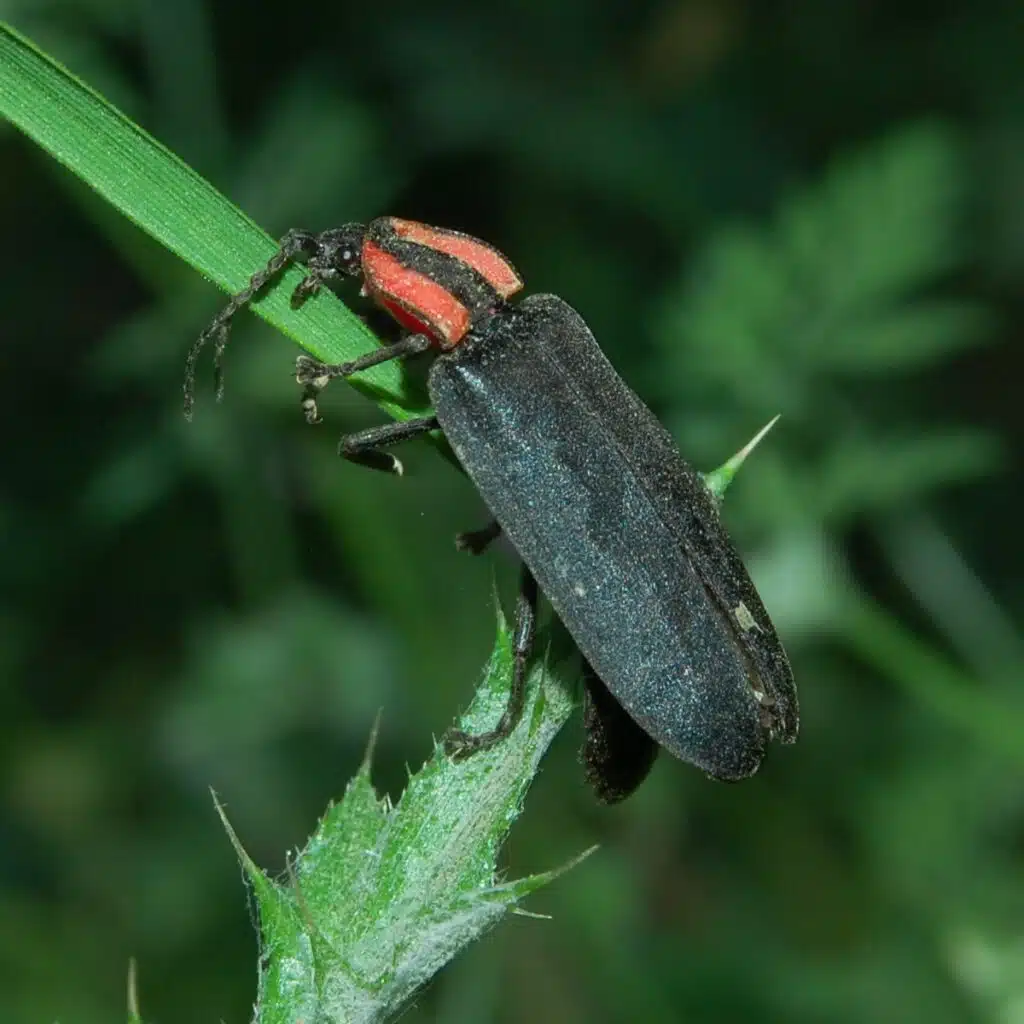
The California Glowworm (Ellychnia californica) is also known as the western firefly. It belongs to the Lampyridae family and is common in North America. They fly during the day, with adults using pheromones rather than light to locate and communicate.
There is not much documentation of this specific firefly species, though they are often encountered in tree trunks during the day. The larvae are carnivorous, feeding on soft-bodied invertebrates, which include slugs, earthworms, and snails.
5. Dark Firefly
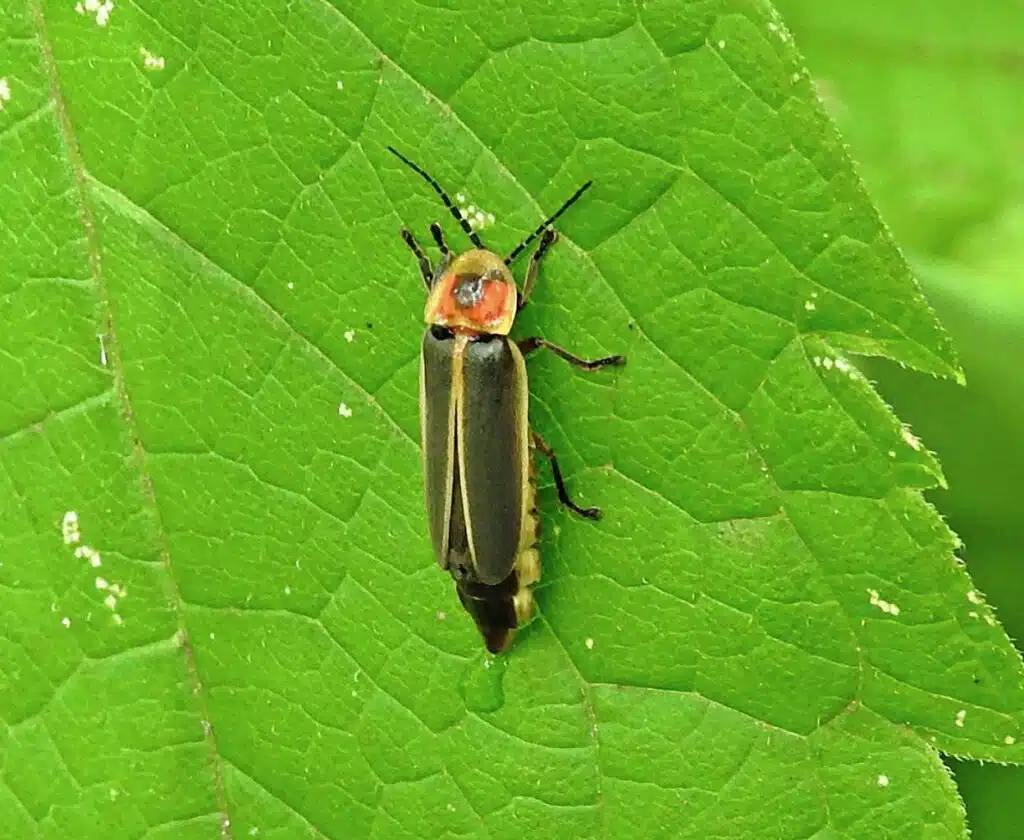
The Dark Firefly (Pyropyga nigricans) is a narrow dark beetle that can grow to 8mm in body length. It is soft-bodied with flattened antennae. The head is hidden under a shield with a black border.
This firefly is common during the day and they do not have luminescence. They are winged and can fly, but most have reduced wings. The male and female use pheromones to find each other.
The larvae feed on small earthworms and snails. Their preferred habitats are around water, such as ponds and swamps.
6. Spring Tree-Top Flasher
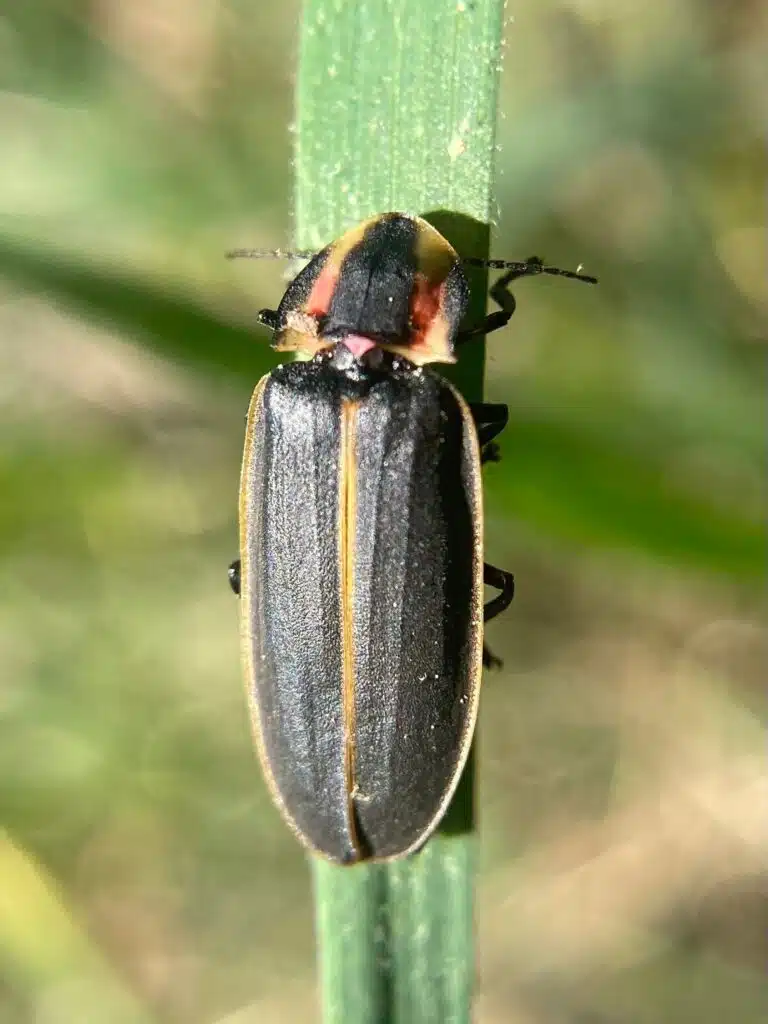
This firefly (Pyractomena borealis) is common in the eastern United States and parts of Canada. Larvae emerge from tree trunks in late winter or early spring. They find a furrow in bark, attach and hang face down to pupate, which lasts several weeks. The larvae pupae are mostly seen on tulip poplars and hickories.
The firefly emerges white and it takes up to twenty-four hours for its exoskeleton to darken and harden. The males emerge a couple of weeks before the females, searching for a female pupa, waiting for her to emerge. He does not flash during this time and fights any males that come too close.
Females have males trying to mate with them before their exoskeleton hardens. She heads to the top of the trees once the exoskeleton hardens and males follow.
This is the earliest firefly to begin flashing. They light up as they fly near bare branches. They only display at night on warm evenings without any rain. They are very active in spring and they mate multiple times.
As adults, they live approximately one month and do not eat during this time. You can see larval and pupal spring treetop flashers on tulip polar and hickory trees during the late winter. Do not disturb them.
Once the larvae start emerging, watch the top of the trees in the evenings to see a lightning display. They flash a yellow flash every couple of seconds for up to ninety minutes after sunset.
7. California Pink Glowworm
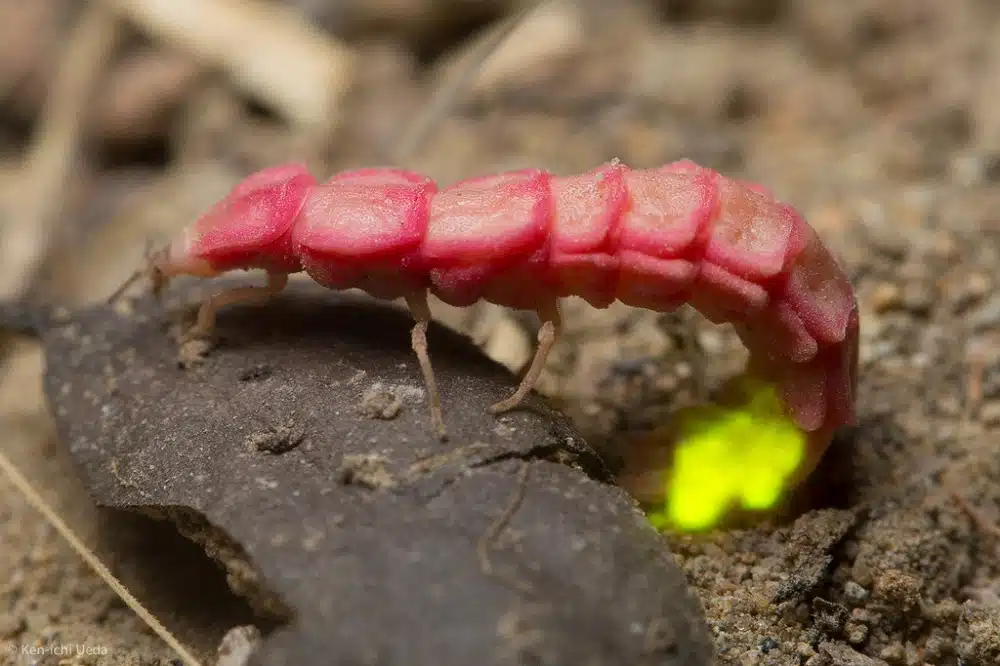
This firefly (Microphotus angustus) is commonly seen by hikers at night. They are common in late spring and early summer. They are easily spotted with their continuous glow used to attract mates.
Larval stages are black with pink margins. The females turn completely pink and look like larvae for their adult years. Males metamorphize into soft-bodied beetles that give a faint glow if disturbed.
8. Douglas Fir Glow-Worm
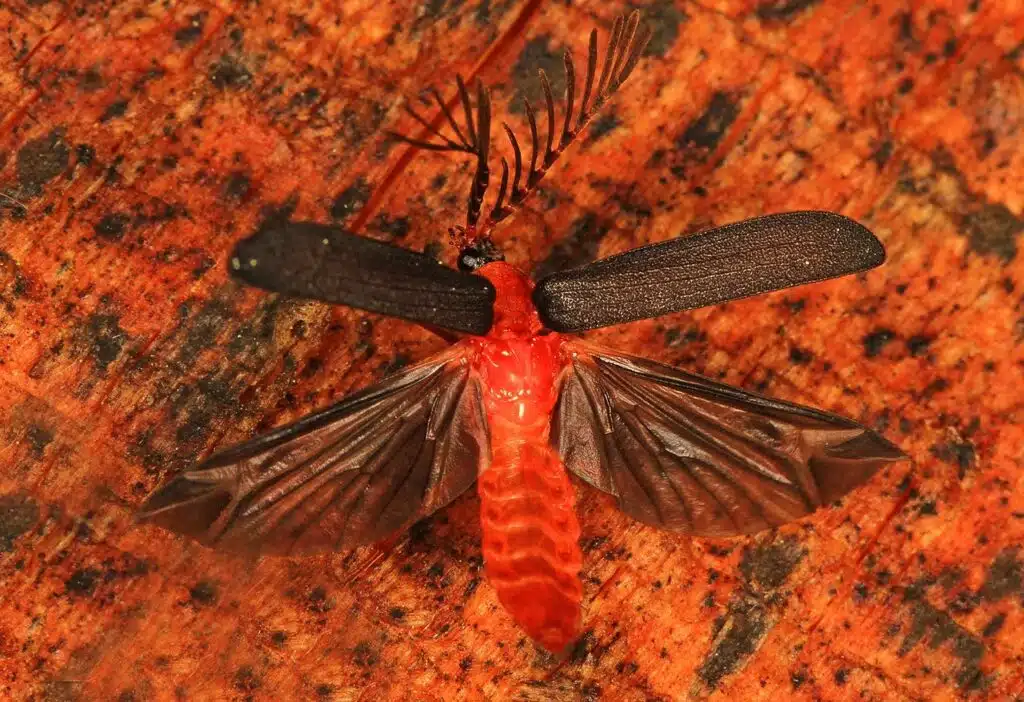
The Douglas Fire Glow-Worm (Pterotus obscuripennis) is a small black beetle with orange trim. When they land, they fan the air with their antennae, scenting for female pheromones. The females are wingless and send out a powerful attractant, guiding the males to their location with a glowing tail.
The larvae glow, but once they reach adulthood, the male loses the ability, growing wings and feelers.
9. Greater Firefly
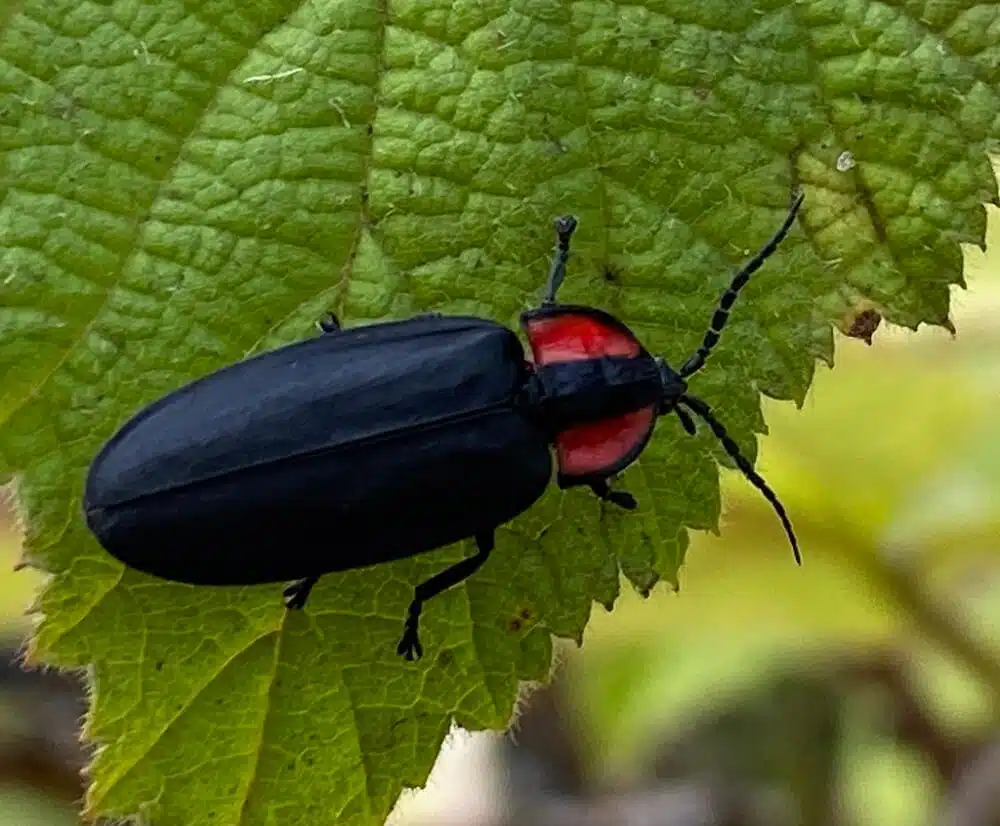
This firefly (Ellychnia megista) was first defined in 1845 and is common across the United States. It is black with rose-colored markings on the pronotum. They are active during the day and do not have light-producing organs.
The males are attracted by chemical signals. As larvae, they live in rotting logs. Unfortunately, there is not much information on this firefly. Even though they are very common nationwide.
10. Say’s Firefly
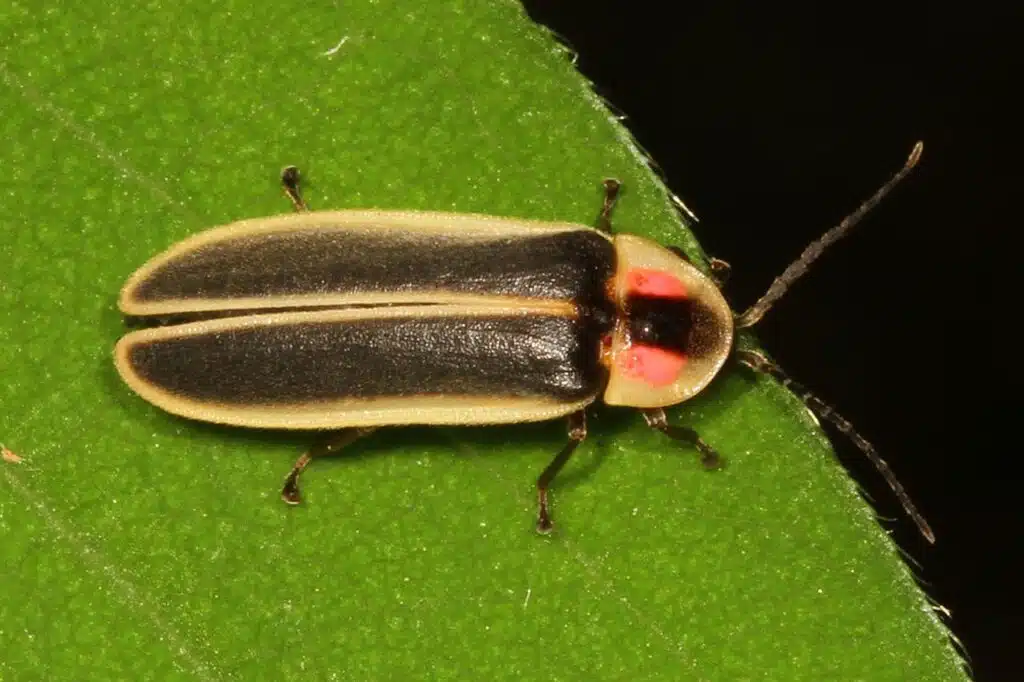
Say’s Firefly (Pyractomena angulata) belongs to the Lampyridae family and is found in North America. It is the state insect of Indiana. This beetle has an amber-colored photoluminescence. It is common in wetlands and visible from May to mid-June.
As adults, they visit flowers of wild parsnip, European horse chestnut, and Broadleaf Plantain. They grow to 11.5mm in body length and are nocturnal.
11. Sneaky Elf
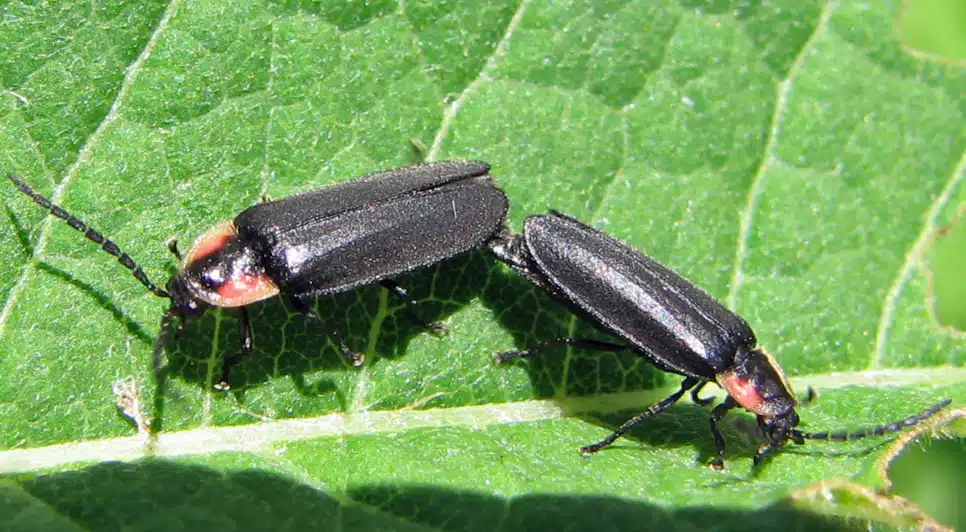
The Sneaky Elf (Pyropyga decipiens) comes out during the spring. It starts to flash at about the same time as the spring treetop flashers. You will see the flashes in the fields.
This beetle omits a stutter of four flashes as they fly. They disappear by the first week of June, usually disappearing before other species start to flash.
12. Little Gray Firefly
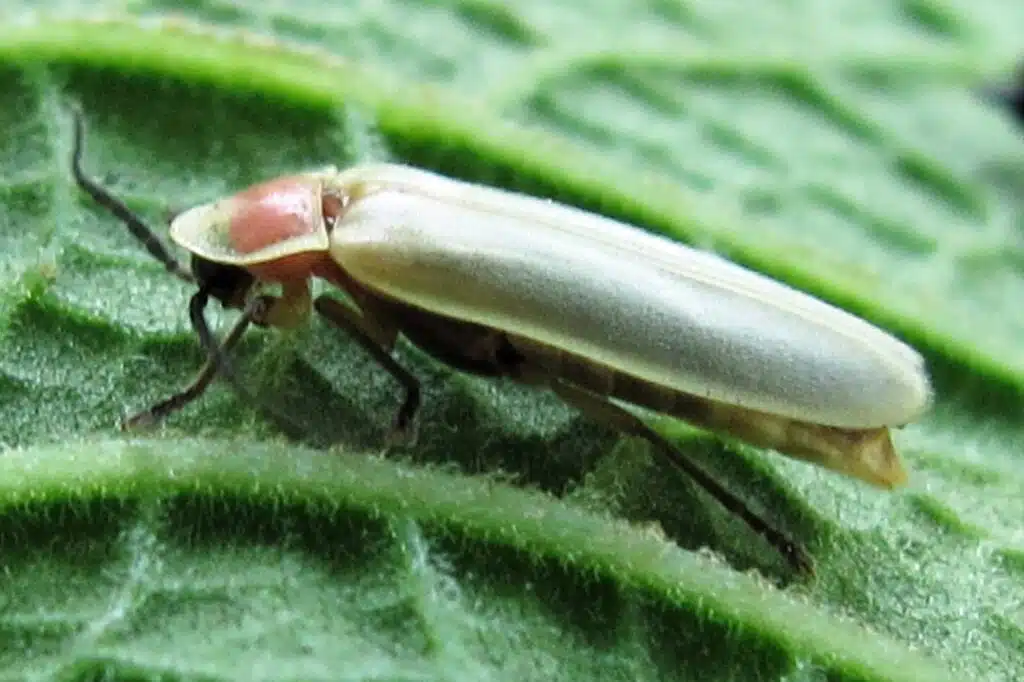
The Little Gray Firefly (Photinus marginellus) belongs to the Lampyridae family and is common in North America. There is a lot of debate around this particular species, as its range overlaps with Photinus Curtatus. They also have almost identical courtship displays.
There are some small differences in coloration between the two species. This species can be found in the eastern United States and Canada. The population size is unknown, though it is common throughout its range.
This is a small firefly that grows to 9mm in body length with variable wing cover. Those n the southern Appalachians have light gray wings and others have darker wings. The male emits a quick flash of light that lasts less than a second during courtship.
The male flashes while flying close to the ground. The females on the ground sit on low vegetation and respond to the male with a single flash. As they flash, the female flexes her abdomen in the direction of the male.
Early in the season, the male outnumbers the female, later in the season, the females outnumber the males. As larvae, they feed on earthworms and other soft-bodied invertebrates below the soil.
13. Blue Ghost Firefly
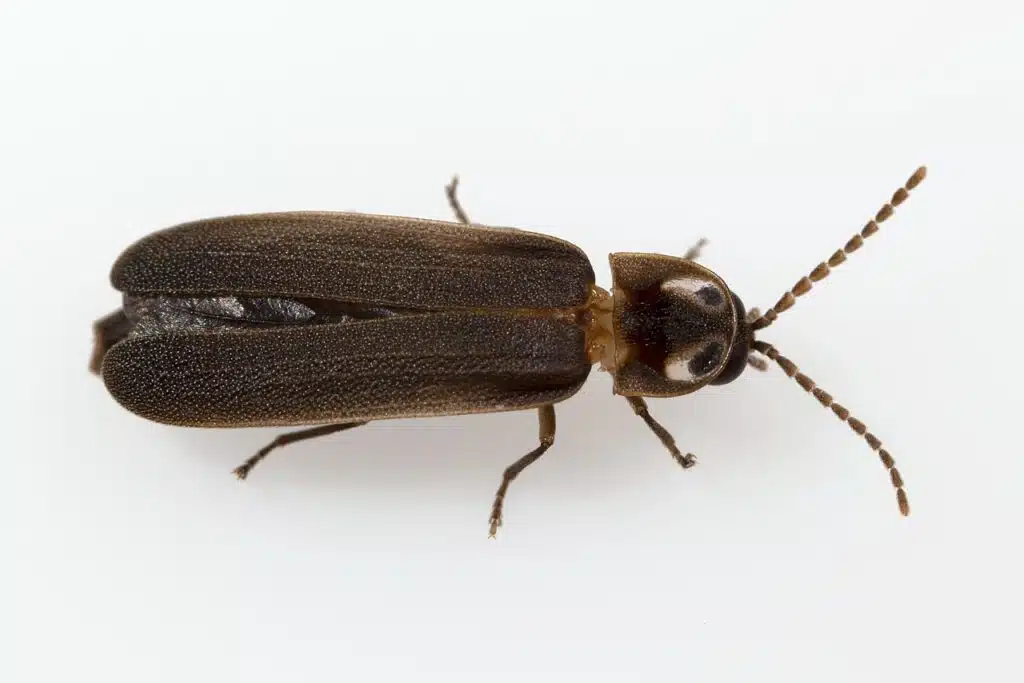
The Blue Ghost Firefly (Phausis reticulata) is also known as the blue ghost and is common in the eastern and central United States. They can be seen in the Great Smoky Mountains National Park, southern Appalachians, North Carolina’s DuPont State Forest, Pisgah National Forest, and Chattahoochee National Forest.
The male is solid brown with short antennae. They have large eyes. They emit a steady glow rather than a flashing pattern. The color they emit shows as blue-white to the human eye.
The female is wingless and cannot fly. She remains in larval form throughout adulthood. The blue ghost firefly prefers warm and moist forest areas to mate. The male flies a few feet off the ground in search of a willing mate.
14. Flower Elf
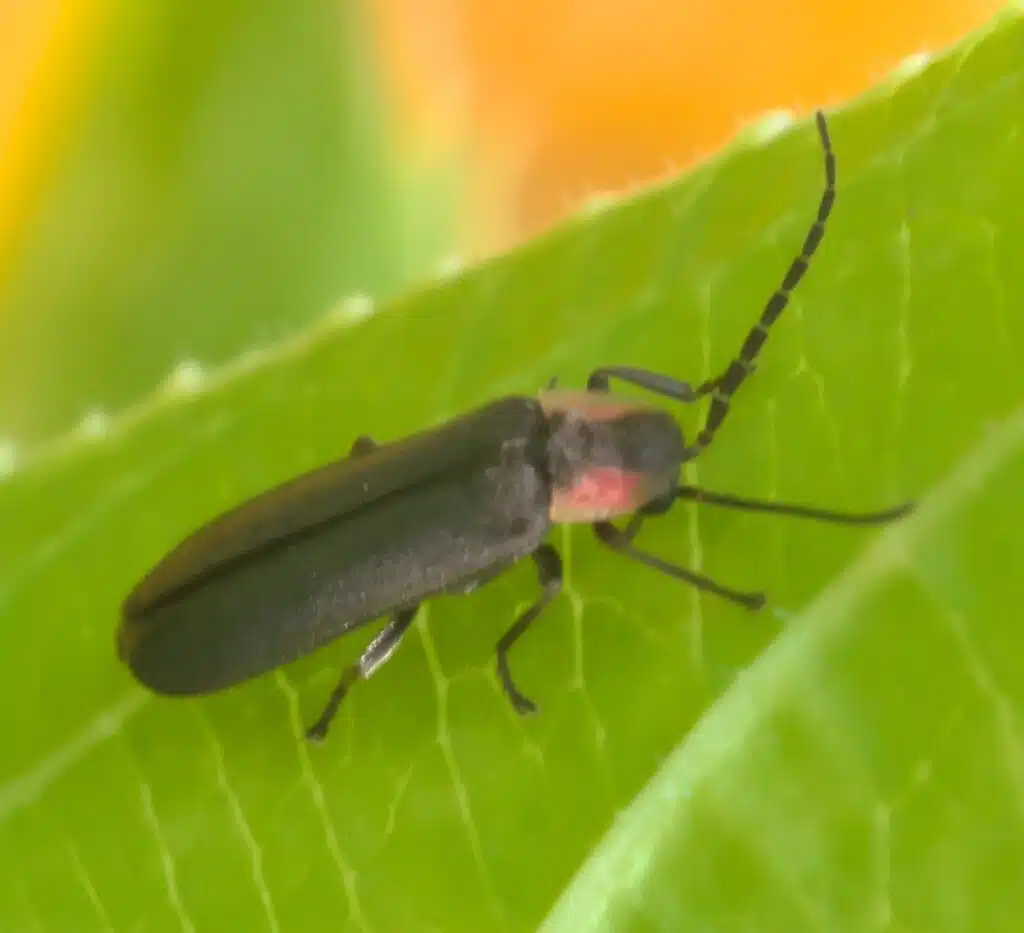
This firefly (Pyropyga minuta) belongs to the Lampyridae family and is common in South America, North America, and Central America. They are widely distributed and often found on willows and milkweed during the summer.
This is a daytime species. There have been no threats documented regarding this species, due to its wide distribution.
This is a very small and dark species. As adults, they prefer tall grasses, and gardens with leaves, and flowers. Courtship is achieved through the release of pheromones, rather than flashing. They are common in June and July.
The larvae feed on gastropods, moth larvae, and earthworms. The adults visit milkweed and willows, feeding on the nectar.
15. Dotted Firefly
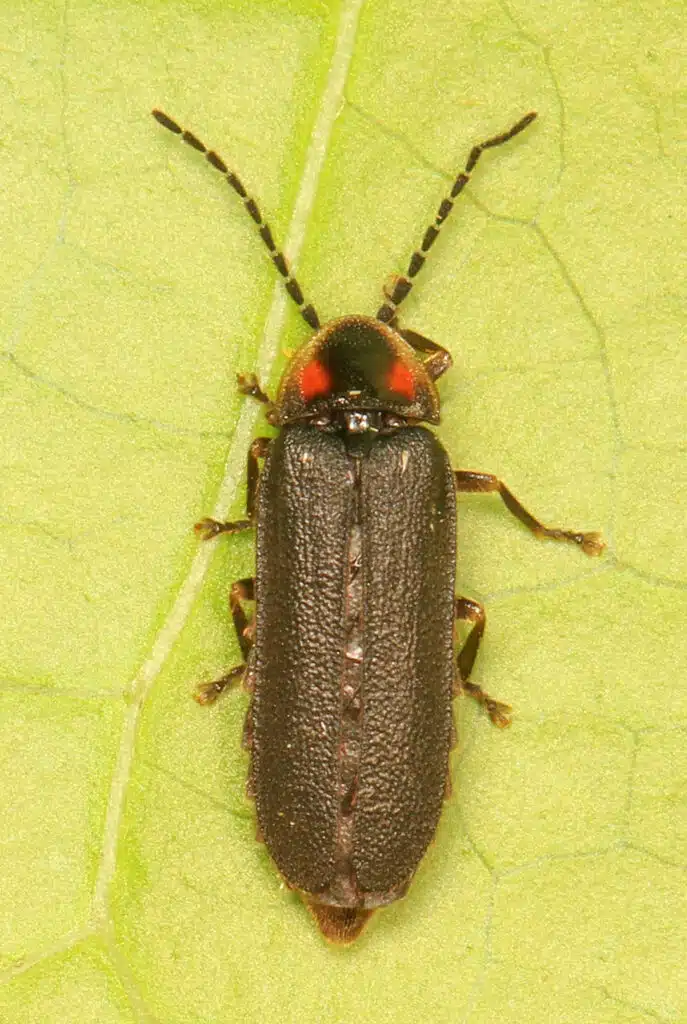
The Dotted Firefly (Lucidota punctata) is a daytime species, distributed throughout eastern North America. It is often seen in shady and moist forests. Adults fly slowly, resting on vegetation and tree trunks. The larvae hide in rotting logs and under leaf litter.
This species is affected by habitat loss, pesticide use, climate change, and habitat degradation. They require moist conditions and are usually found near water.
This daytime firefly relies on pheromones to attract a mate rather than photoluminescence. They are common in moist and open areas, primarily deciduous and mixed forests. The adults are active from May to July. The larvae feed on worms, soft-bodied insects, and earthworms.